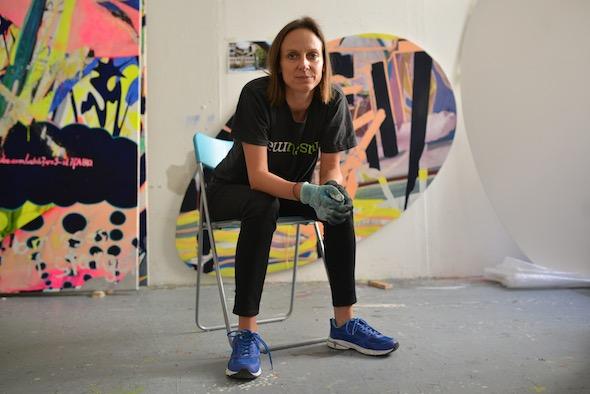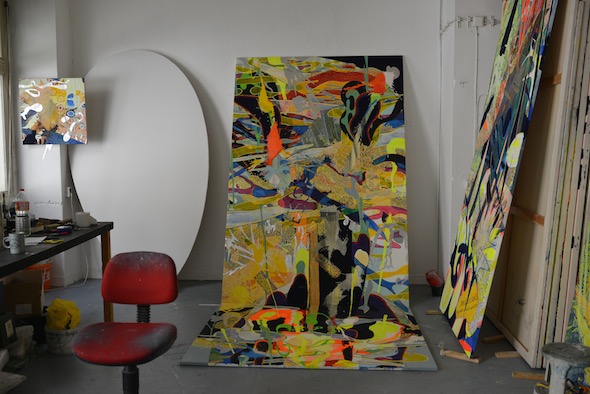Studio Visit with Claudia Chaseling
Studio Visit with Claudia Chaseling

We met with artist Claudia Chaseling at her Berlin studio, a space that she’s been working out of for the last ten years – between frequent travels to Australia, where she is currently completing a studio-based PhD. In her studio, tall, vertical canvases in chaotic combinations of radioactive, translucent, rich, deep hues worked over in multiple layers line the walls, while other objects and works on paper elaborate on and punctuate the narratives of process, subject and inspiration. She talked to us about how these elements weave together in her semi-abstract, dynamic spatial paintings that seem to mutate within – as well as have a mutational power over – the spaces they inhabit:
My spatial paintings are composed from one particular viewpoint, and from that viewpoint they become totally flat. Then, when you look at them from the side, you see how they’re actually placed in the space.
Would you say they are quite site-specific then?
I call it site-mutative, because it doesn’t matter for me where they are, but the key is that they change the space. I’m always after a particular sense of deterioration, imbalance and distortion. Because of this, I discovered that aluminum has a character that I really need in painting, as it goes both into the depths and comes towards you – as well as distorts the image. I also work a lot with reverse perspective – it’s a medieval technique. Usually, the subject of the work is the closest. In a reverse perspective, it’s often that which is close to you is small and then things get larger, so that the distance actually comes forward. Through this method, I can really alter the space.
Besides aluminum, what other types of materials do you use in your paintings?
Pigment, egg tempera and sometimes I use a binder called MDM binder. Usually the paintings on canvas have egg tempera underneath and then oil on top, but only in parts – that way, I get this physical depth on the surface of the painting.
I work in layers. I figure out which layers of color radiate a real intensity. During the process, I also pour wax on top of the painting, continue painting and then remove the wax and these organic shapes occur. The shapes really complement my idea about the organic being deteriorated by something. It all has this destructive quality. For text, I use floorpeel – after it's painted, I just remove it again and then I have this negative shape of the text, which really floats into the painting.
As we walk through her studio, observing the paintings propped against the walls, which consume and enliven the space with their striking presence, she points out images in books and catalogues of her earlier works and past installations – many of which were temporary and exist now only in documentation.

My earlier paintings were also quite large and focused on urban landscapes, which the human impact had made uninhabitable: these gray zones, like industrial areas or under bridges. I was also interested in painting that which is in between things – not just a thing itself. I was never after painting something that I can easily see, but always trying to find a sense or an atmosphere of a particular situation or subject. That was a big focus. But then, in 2005, I saw a documentary about the use of depleted uranium munitions, and that became the primary subject for me. From these landscape paintings I went into more directly political work about radioactive contamination. I had a series that I started with mutated animals, because contamination changes your DNA, and usually the affected subject gets cancer, but it could also lead to deformations in offspring. For me, it was always too direct to paint a five-legged dog, for example, because I’m not interested in making a caricature. I really try to follow the energy of the abstract, to discover what I can do with abstract paintings so that they really touch you and transport meaning.
In the more recent ones, I decided to add text to bring the observer to the subject. The abstract impact is what I’m looking for, but then – by including a web link – you have a chance to track down where this energy comes from. I really want to spread knowledge about all these things. There’s also a cartoon – 'Murphy the Mutant' – that gives a really good background. This graphic novel was a first attempt to bridge the concept with these works.
Do your graphic novels ever take the form of your large-scale paintings and installations, or are they conceived of as separate objects with their own form and language?
There’s a little bit of fusing. Some paintings have a sort of comic language. And I made one painting that I called 'Murphy'. For a while, when I started making this graphic novel, people would ask me what I was doing and whether I would call myself an installation artist, sculptor, painter or comic artist. And I thought about it and then I thought, but why all these categories? And then I just went full power in every direction. I always start something the same way. It’s the same language for me. It’s just a different form. But the form also develops from painting. What are the borders of a painting today? How much can I do with color; how can I refine that color language so that it gets really intense and really precise?
Can you talk a bit more about your working process?
For every painting, I make a watercolor – for the spatial paintings, I make about 20 drafts. I think in pictures. I have to work on something for a long time, until it formally fits – until I’ve found the right dynamic. But I also need to develop the subject for a long time.
Making postcards really allows me to develop my abstract language, because they're such highly concentrated, small diary-like pieces. I make a lot of them. I think that through this focus and identifying of subject I come to these weird forms, which really speak for something.

Are the postcards something that you continually produce?
Yes, all the time. I have hundreds of them. When I was in a residency in Australia as a visiting artist, I made 100 over the course of two months and exhibited them in one line through the space. It's amazing how they worked together and captured that time so precisely – in full detail. The vibe that came from them was incredible. I then discovered that abstraction could be very precise.
You’ve mentioned Byzantine and Aboriginal Australian painting as influential to your work and mode of expression through abstraction. Apart from those, what are some other influences?
From early on, it's Cezanne and Matisse. There's one particular painting called 'Piano Lesson' from Matisse, which I saw at MoMA in New York. I had always thought that I would have to decide whether my work would be abstract, or purely abstract. But I'm a real anti-formalist. I use the materiality of the paint to make it speak. I could never just make brushstrokes or lines or color fields. I could not paint without having reasons or things to paint or communicate. I was also always figurative – a storyteller – and when I saw this painting, I realized I could do what I wanted. It has such a strong atmosphere; it's really radiating something. I started to look for that. Then, of course, there are the American Expressionists. I looked a lot at de Kooning and I always found Franz Kline fascinating: the directness and immediacy of his paint. There are two artists that are really important now – contemporary. An Australian artist called eX de Medici; she's a painter, very political, and makes huge watercolors, but comes from a performance background. And the other is here in Berlin – Milovan DeStil Marković. He's originally from Yugoslavia. He's also a painter, and in the 80s he started pulling apart the idea of the canvas: making canvases with holes. He used mirrors and aluminum and tore it all up. Later artists started talking about fragmentation and fragmenting perspective, but he had already done it back then. We talk a lot about art; it's a huge exchange. His work is also currently in a show with mine at Schlachthaus. fresh&fine art, Berlin.
What, if any, new directions do you see your work going in? Are you working on anything new?
I’m working now with oval-shaped canvases, and continuing to work with making spatial paintings. I don't know how long it will take me to make these, because it's very different to work on a round shape. I then want to make spatial paintings with them. The question is always: why does the canvas have to be square? I find this form makes much more sense for me because it merges the spatial paintings with the canvas. There's also one other thing: I will add some aluminum leaf and see how that works in the paintings – instead of cutout aluminum shapes.
Other than spatial painting and works on canvas, do you plan to show anything else in your upcoming exhibition at Magic Beans Gallery this September?
There are two glass sculptures, separately, which were named for animals in space. They’re pigment in glass. These objects have no senses – no nose, no eyes – and they're quite passive, just like an animal that got shot into space. For me, it's also a metaphor for humans: you’re born into the world, you don't know where you come from, then you live here, you think you're in charge but you're actually not. Then you die, you disappear somewhere and you don't know where you go. This is my metaphor: the painted space is like our reality and then, outside of what is painted, is the past and the future.

***
Claudia Chaseling Magic Beans Opening September more info